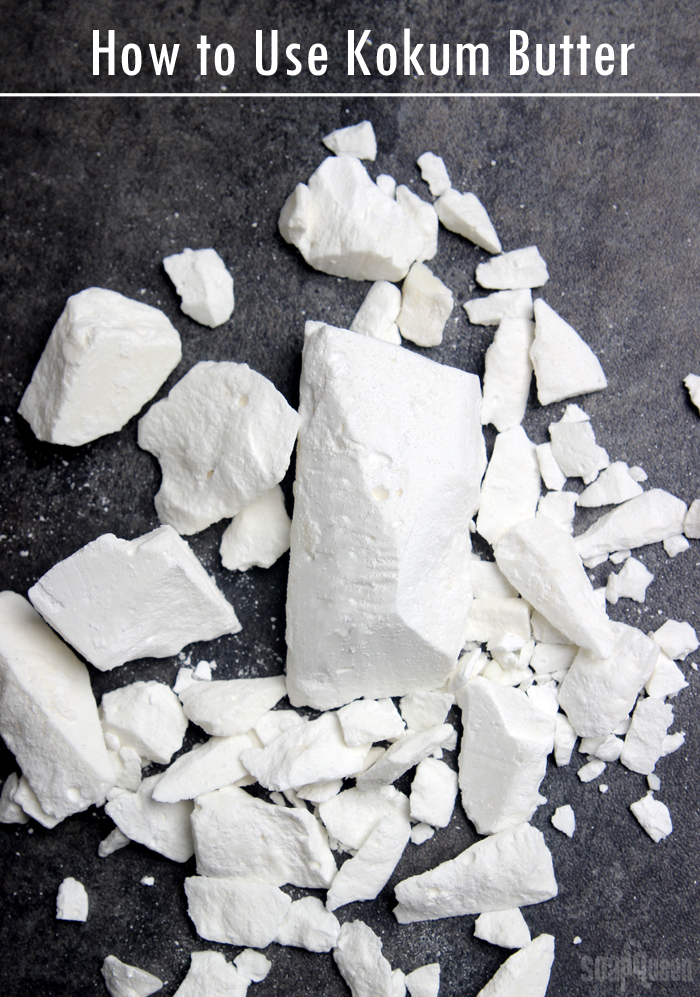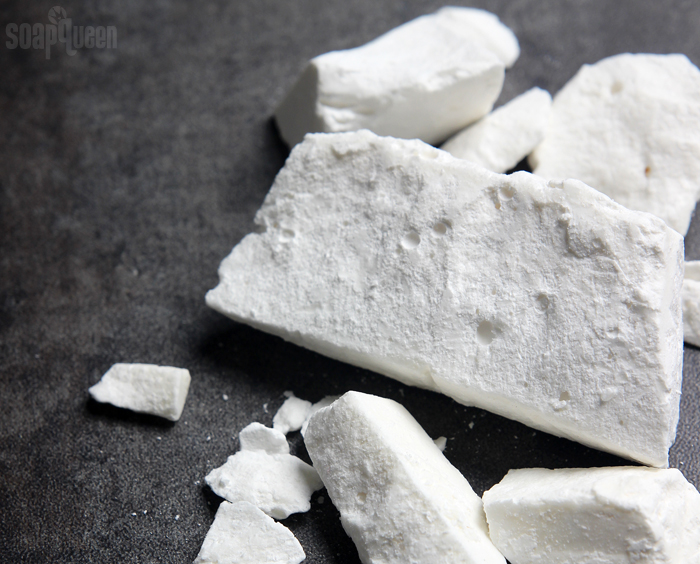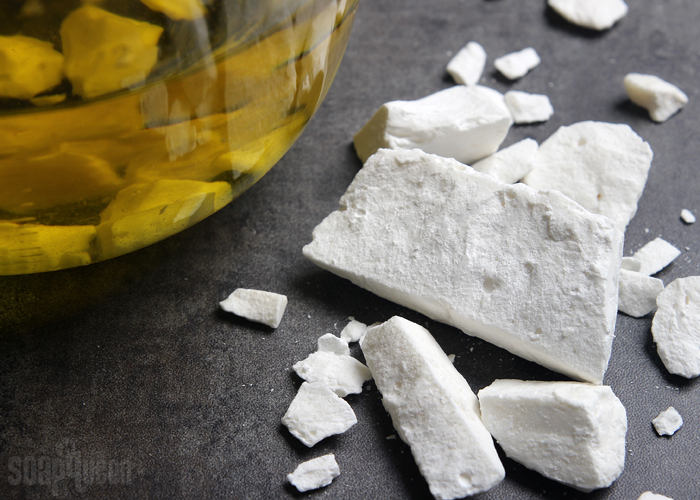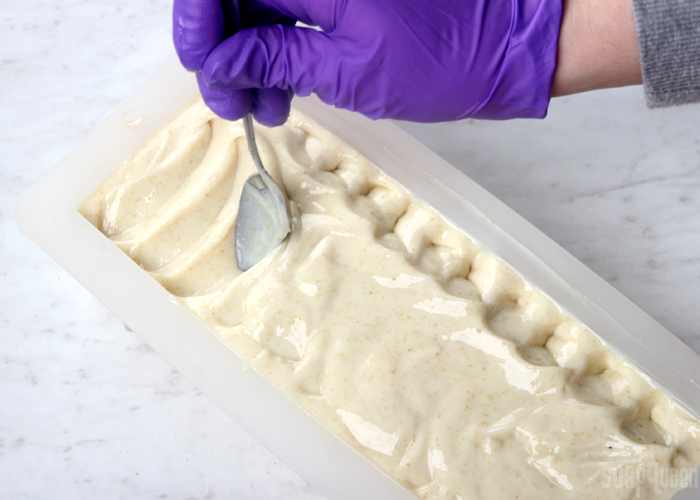
At first glance, kokum butter looks a bit odd. It’s crumbly and almost looks like it’s covered in soda ash. But within those pieces of butter is something really special. It’s ultra moisturizing, and leaves your hair and skin feeling soft and silky.
Kokum butter has a firm texture that’s similar to cocoa butter. It’s firmer and more crumbly than other butters Bramble Berry carries, including shea and mango. Read all about butters here. Kokum starts to melt around 90-104 ° F. So, when it comes in contact with the skin, it melts just slightly. It feels lightweight and not greasy. It can be used on its own to moisturize the skin, lips or hair. You can also use that texture in combination with other ingredients to make amazing body butter, lip balm, soap and more. Before getting started on your kokum butter creations, there are a few things to know.

The butter comes from the fruit kernels of the Indian tree, also known as Garcinia indica. It’s indigenous to the Western Ghats region of India. It has a high stearic acid content of around 40-45%. That stearic acid content does a few things. First, it adds firming properties to your recipes. It also helps thicken products like lotion and conditioner. Read more about stearic acid in this Swift Crafty Monkey post. This one on butters is pretty great too. Kokum butter is also one of the most stable vegetable butters with a shelf life of about 1-2 years. As an added bonus, kokum butter has little to no scent. That means it won’t compete with fragrance or essential oil in your handmade products.
Now that you’re completely sold on kokum butter and its amazing benefits, you’re probably wondering how to use it in your products. Don’t worry, we’ve got you covered!

Cold Process Soap
Kokum butter can be used in soap up to 10%. Because of that high stearic acid content, a larger amount can cause the soap to trace fairly quickly. Learn more about trace in this post. We like to use it around 5%. That gives you all the moisturizing benefits and creates a firmer bar. We added the butter to a recipe with ground pumpkin seeds and eucalyptus essential oil. Look out for that tutorial later this week. As for melt and pour, we don’t recommend adding extra butter. It can make the bases oily or soft. If you do add kokum butter to melt and pour soap, use no more than 1 teaspoon per pound of MP soap.
 This cold process soap recipe featuring kokum butter, ground pumpkin seeds and eucalyptus essential oil will be up later this week.
This cold process soap recipe featuring kokum butter, ground pumpkin seeds and eucalyptus essential oil will be up later this week.
Lotion/Conditioner
The stearic acid content of kokum butter is important to consider in emulsified products like lotion and conditioner. In higher concentrations, the butter can make the formula too thick. Using about 1-3% in your recipe will work nicely. You may also want to decrease the amount of stearic acid. It is usually recommended at 3-5%. You can drop that to 2-3%. That will give you a lotion or conditioner that’s thick and luxurious. Learn more about making lotion in this post. If you want to make conditioner, this video shows you how.
Balms
Kokum butter can be used on its own in body and lip balms, although it will be very firm. If you prefer a softer texture, you can use it at 5% and up. A traditional balm formula is 1:1:1 wax, butter and oil. Kokum butter pairs nicely with beeswax, cera bellina wax or candelilla wax. As for oil, the sky is the limit! Sweet almond, avocado or chia seed oil feel super moisturizing. Before you get started on your balm, pop a few spoons in the freezer. This is called The Spoon Trick. When you dip the cold spoons into the melted balm, it hardens instantly so you can check the texture. If it’s too soft or too firm, you can adjust from there. Learn more about formulating balms in this post.
Body Butter
The texture of kokum butter is perfect for a hydrating body butter. Because kokum butter is firm, you’ll want to melt it before whipping. On its own it will be too stiff, so you can use it at 5% or more in combination with a softer butter like coffee or avocado to make the recipe more balanced. Liquid oils like argan or meadowfoam feel nice in body butter recipes as well. They add a silky, spreadable feeling. Kokum butter would be a great addition or substitute for cocoa butter in this recipe.
 Kokum would be a great addition to the Whipped Amber Bronzing Butter.
Kokum would be a great addition to the Whipped Amber Bronzing Butter.
Scrubs
If you want to add moisturizing properties to your scrub, kokum butter is the way to go. On it’s own, kokum butter is too firm to mix with an exfoliant, but would be great with a liquid oil or softer butter. Give it a try in the Sparkling Snow Sugar Scrub in place of shea butter.
Bath Bombs
Oil and butter wet bath bombs, which helps them hold their shape. They also moisturize the skin. You can add about .5 oz. of melted kokum butter per 1.5 cups of fizzy mixture to start with. If you want the bath bombs wetter, you can add more from there. Get more tips in the Bath Bomb Questions and Answers post.
Have you used kokum butter before? What’s your favorite way to use it?
The post How to Use Kokum Butter appeared first on Soap Queen.
Keine Kommentare:
Kommentar veröffentlichen